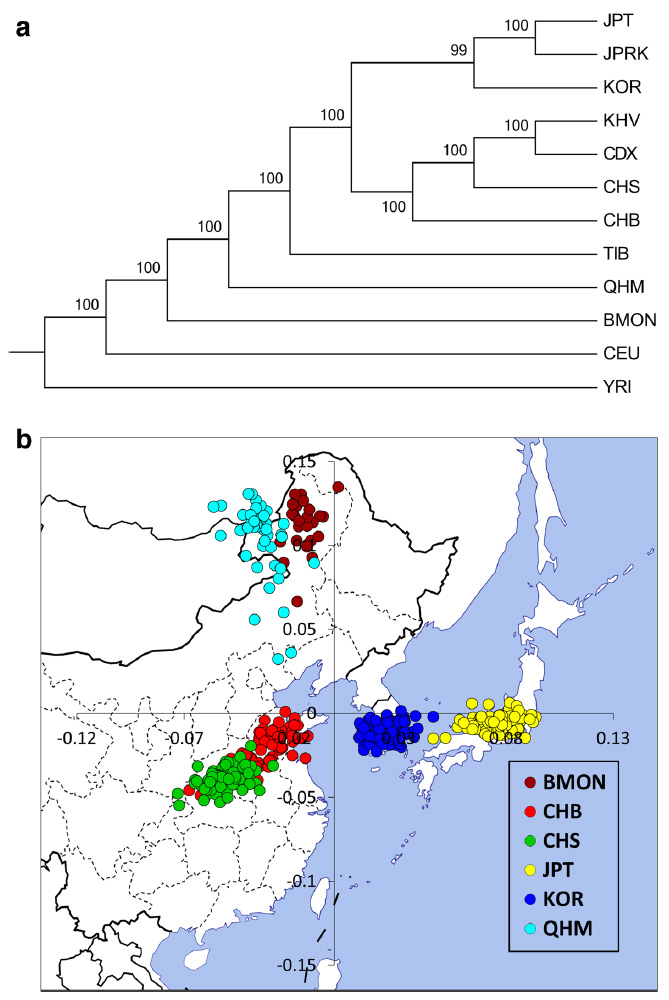Open access Genetic structure, divergence and admixture of Han Chinese, Japanese and Korean populations, by Wang, Lu, Chung, and Xu, Hereditas (2018) 155:19.
Abstract (emphasis mine):
Background
Han Chinese, Japanese and Korean, the three major ethnic groups of East Asia, share many similarities in appearance, language and culture etc., but their genetic relationships, divergence times and subsequent genetic exchanges have not been well studied.Results
We conducted a genome-wide study and evaluated the population structure of 182 Han Chinese, 90 Japanese and 100 Korean individuals, together with the data of 630 individuals representing 8 populations wordwide. Our analyses revealed that Han Chinese, Japanese and Korean populations have distinct genetic makeup and can be well distinguished based on either the genome wide data or a panel of ancestry informative markers (AIMs). Their genetic structure corresponds well to their geographical distributions, indicating geographical isolation played a critical role in driving population differentiation in East Asia. The most recent common ancestor of the three populations was dated back to 3000 ~ 3600 years ago. Our analyses also revealed substantial admixture within the three populations which occurred subsequent to initial splits, and distinct gene introgression from surrounding populations, of which northern ancestral component is dominant.Conclusions
These estimations and findings facilitate to understanding population history and mechanism of human genetic diversity in East Asia, and have implications for both evolutionary and medical studies.

Interesting excerpts:
It is obvious that the genetic difference among the three East Asian groups initially resulted from population divergence due to pre-historical or historical migrations. Subsequently, different geographical locations where the three populations are located, mainland of China, Korean Peninsular and Japanese archipelago, respectively, apparently facilitated population differentiation due to physical isolation and independent genetic drift. Our estimations of population divergence time among the three groups, 1.2~ 3.6 KYA, are largely consistent with known history of the three populations and those related. However, considering that recent admixture could have reduced genetic difference between populations, it is likely the divergence time was underestimated.
We detected substantial gene flow among the three populations and also from the surrounding populations. For example, based on our analysis with the F3 test, Korean received gene flow from Han Chinese and Japanese, and gene flow also happened between Han Chinese and Japanese (Additional file 12: Table S3). These gene flows are expected to have reduced the genetic differentiation between the three ethnic groups. On the other hand, we also detected considerable gene flow from surrounding populations to the three populations studied. For instance, an ancestral population represented by Ryukyuan have contributed greater to Japanese than to Han Chinese, while southern ethnic group like Dai have contributed more to continent populations than to island and peninsula populations. Contrary to the gene flow among the three populations, these gene flows from surrounding populations are expected to have increased genetic difference among the three populations if they occurred independently and from different source populations. According to our results, the major source of gene flow to the three ethnic groups were substantially different, for example, the major source of gene flow to Han Chinese was from southern ethnic groups, the major source of gene flow to Japanese was from southern islands, and the major source of gene flow to Korean were from both mainland and islands. Therefore, those gene flows might have significantly contributed to further genetic differentiation of the three populations.
The three populations have similar but not identical demographical history; they all experience a strong population expansion in the last 20,000 years. However, according to different geographic distribution, their effective population size and population expansion are different.
Although based on modern populations, the study is interesting in light of the potential implications for a Macro-Altaic proposal.
Related:
- Model for the spread of Transeurasian (Macro-Altaic) communities with farming
- Y chromosome C2*-star cluster traces back to ordinary Mongols, rather than Genghis Khan
- Expansion of peoples associated with spread of haplogroups: Mongols and C3*-F3918, Arabs and E-M183 (M81)
- Ancient genomes document multiple waves of migration in south-east Asian prehistory
- Genomics reveals four prehistoric migration waves into South-East Asia
- Population turnover in Remote Oceania shortly after initial settlement
- Language continuity despite population replacement in Remote Oceania